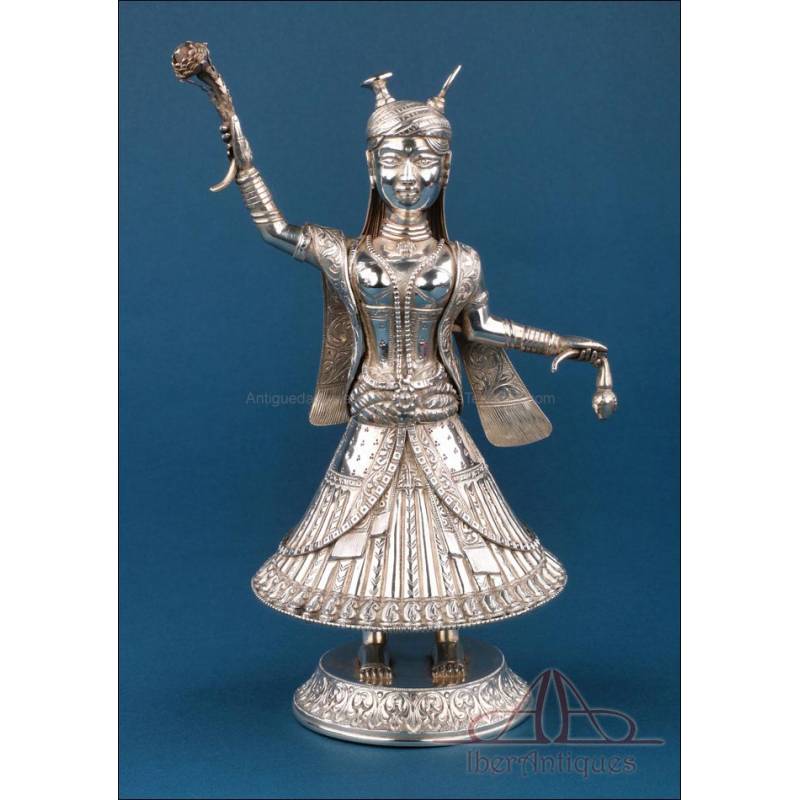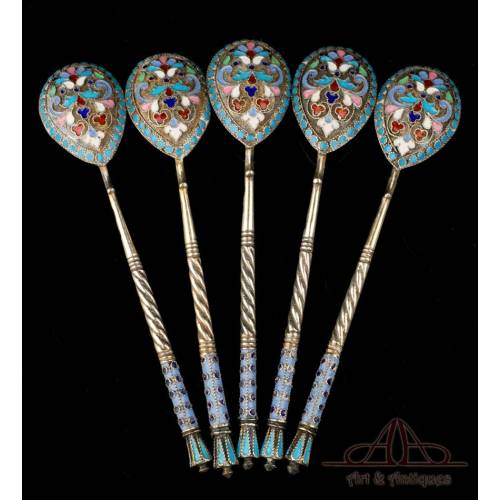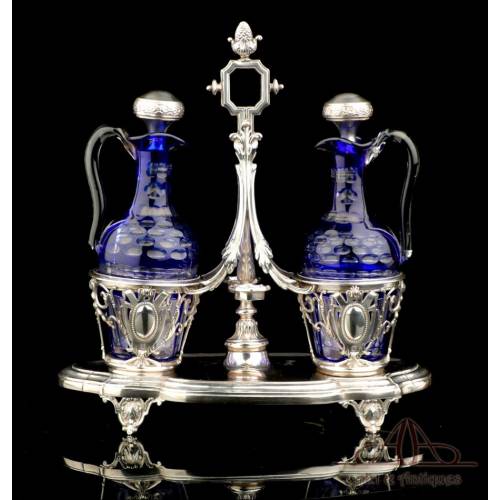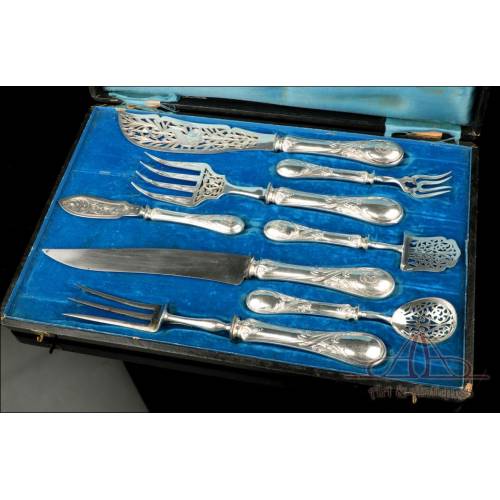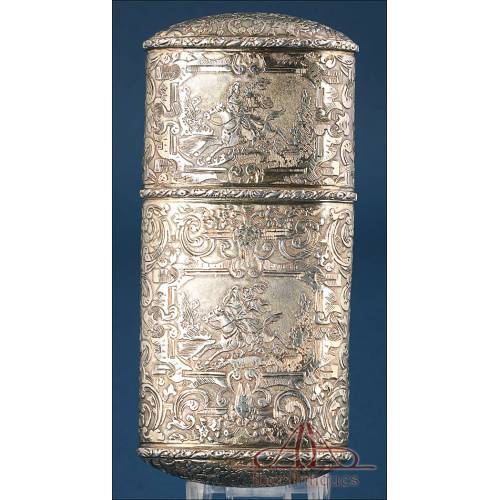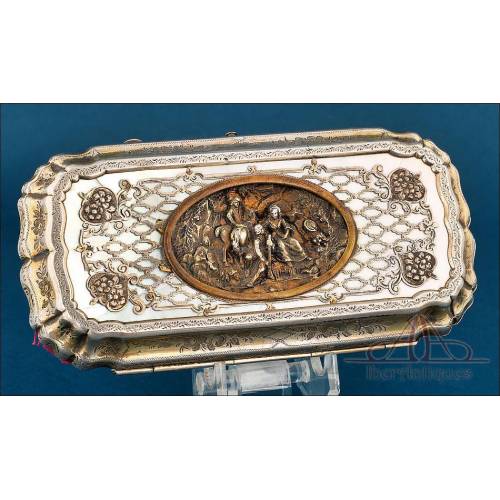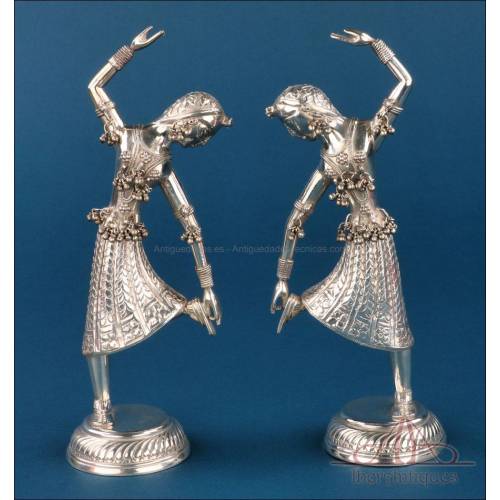E-281
Solid silver Hindu figure, deity or ritual dancer, India or Nepal, ca. 1960s
Solid silver Hindu figure, possibly a deity or ritual dancer, finely crafted with floral details. India or Nepal, 1960s. Decorative and symbolic piece.
Solid silver Hindu figure, deity or ritual dancer, India or Nepal, 1960s
This majestic female figure in 900 silver sits at a fascinating intersection between devotional art and sacred dance. Artisanally crafted around the 1960s, its origins lie in the rich iconographic traditions of India or Nepal. Standing 25.5 cm tall and weighing 989 grams, this sculpture is impressive, vibrant and profoundly symbolic, ideal for collectors of Asian art, spiritual objects or cultural artifacts from South Asia.
The piece can be interpreted in two complementary ways, either as a stylized representation of a female deity, perhaps a serene form of Lakshmi or Parvati, or as a ritual dancer inspired by Bharatanatyam, one of India’s oldest and most revered classical dance styles. This symbolic ambiguity, far from diminishing its value, makes it an even more fascinating and versatile work of art.
The costume is key, with a flared, pleated skirt evoking devotional dance movements, a richly decorated vest, and meticulous ornamentation covering the torso, arms and base with floral and geometric patterns. Every detail has been hand-worked using repoussé and chasing techniques, creating depth and textures that beautifully catch the light.
Its pose, with outstretched arms and symbolic objects in each hand, reinforces this dual interpretation. In her right hand, she holds a flower, very likely a lotus, a universal symbol of purity and spiritual awakening, and in her left, a rounded object that could represent a bell, a pomegranate or ritual fruit. These could be understood as divine attributes or as accessories used in sacred performance.
Her face is symmetrical and serene, with a calm gaze and refined features reminiscent of Hindu or Tibetan Buddhist divine figures. The elaborate headpiece with upward-pointing projections adds a ceremonial feel, often associated with celestial beings such as apsaras, heavenly nymphs found in Hindu and Buddhist cosmology.
The round base, finely adorned, adds visual and physical stability, completing the piece with elegance and proportion. The underside is marked “900”, confirming its composition in high-purity silver.
Exceptionally well preserved, the sculpture shows no visible cracks or damage and only carries a light natural patina from age, which adds authenticity. It can be polished to a brighter finish if preferred.
A powerful decorative object, perfect for a spiritual corner or to enhance an ethnic-inspired design space with character and meaning. It also makes a unique gift or a solid investment in artisan silver art.
Bring home a figure that beautifully merges the sacred and the artistic, spirituality and movement.
Measurements: 25.5 x 12.5 x 9.5 cm (10.04 x 4.92 x 3.74 in). Weight: 989 g.
History of Silver Sculpture in South Asia
Sculpting in precious metals has played a central role in the artistic and religious traditions of South Asia for over a thousand years. In both India and Nepal, silver and bronze figures were created not only for devotional use but also to honor the visual language of sacred performance. Among the most common subjects are Hindu deities like Lakshmi, Parvati, Saraswati or Durga, as well as celestial dancers such as apsaras, who symbolize grace, beauty and divine inspiration.
A particularly strong connection exists between classical dance and religious practice. In southern India, Bharatanatyam developed as a sacred form of worship through movement in temples, where the body itself was seen as a divine instrument. Devadasis, women dedicated to temple service, performed dances that embodied sacred stories and spiritual truths. From this tradition, many figures emerged that, even when not depicting a specific deity, carried a sacred presence through their gestures and attire.
In the 1960s, during a time of growing international interest in Eastern cultures, traditional-style silver sculptures became popular among collectors and travelers. Many such works, like this one, were made by skilled artisans using long-standing methods passed down through generations. While some were not used in formal worship, they retained deep iconographic symbolism and high-quality execution.
The use of 900 silver, as in this piece, ensures lasting durability, value and brilliance, turning each sculpture into a lasting cultural and aesthetic asset. This figure is a beautiful example of the harmony between ritual purpose and ornamental craftsmanship during a pivotal moment in modern South Asian artisan history.

